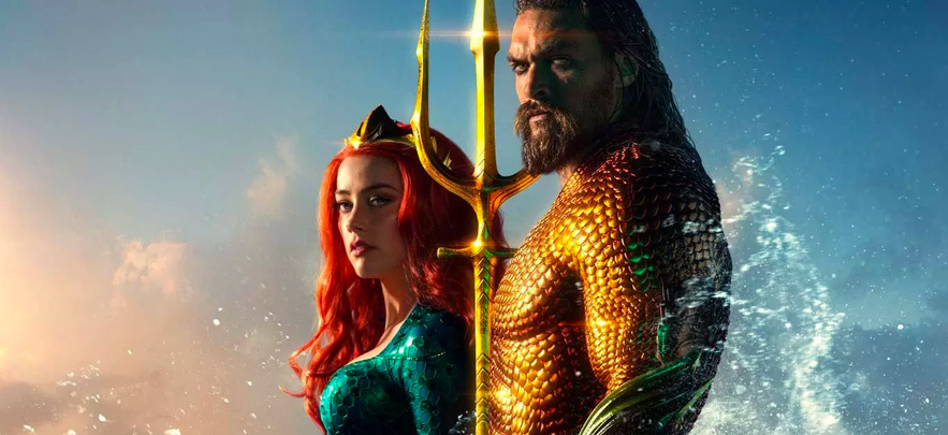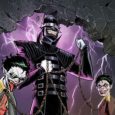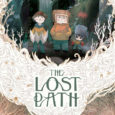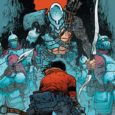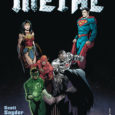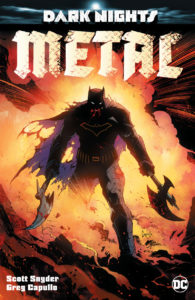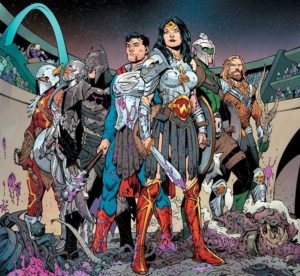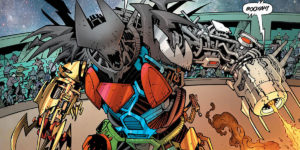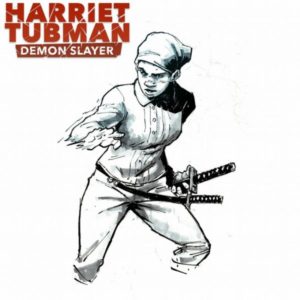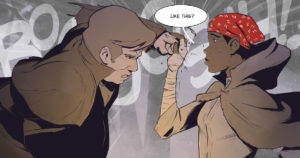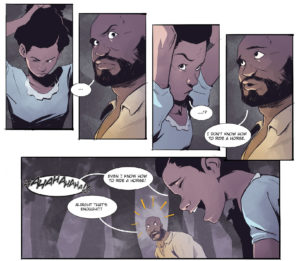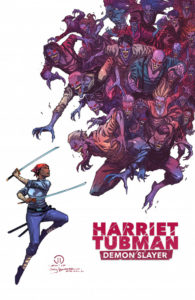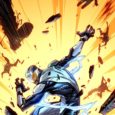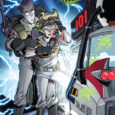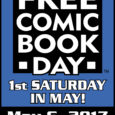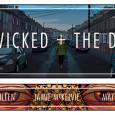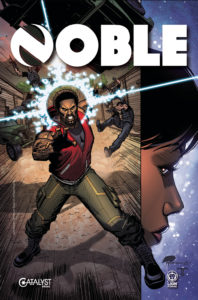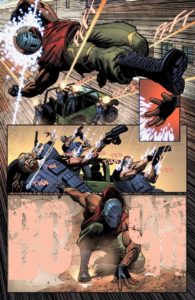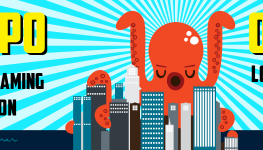Hello DC, my old friend… I have come to punish myself with you again.
Boy howdy. Here we are with Aqauman after 5 years of mostly failed DC movie attempts. Last time I saw the character of Aquaman, he was in the totally and completely awful Justice League, and to be fair, he was more of an Aquabro rather than an Aquaman. The lines and presence in Justice League was painful, but is it possible that Aquaman could have a shot at redemption?
Bad lines and kind of an off putting performance by Jason Momoa in Justice League really made me not care about the character at all. He was already a joke being the super hero that talks to fishes, and I did not know how a screen portrayal would work. It seemed like a arc out of the show Entourage, oh wait it was an arc in Entourage. Aquaman, in my eyes, just seemed hell bent on being another bad DC movie.
It should be to no surprise that I spent most of 2018 just piling on Aquaman. Every trailer and poster released had instant reactions from me, where I just could not help myself. I was compelled to pile on this movie with as much negativity as I could muster. As people started to see the film, and reviews started to come in, the word of mouth was mostly positive. I of course, began to construct many tin foil hat theories that these were DC fans in early screenings, and DC fans reviewing it. It had to be!
 There was only one way to put an end to this… I had to see it for myself. Now after the Justice League fiasco, I was in a hard refusal mode to give DC any more of my money, and time. Something about our generation has that overwhelming feeling of the fear of missing out… and while I had no fears of missing out on an Aquaman movie, I felt disingenuous to continue my professional career of hating DC, and especially hating on this movie. I needed to find out for myself, and inform my empty hatred.
There was only one way to put an end to this… I had to see it for myself. Now after the Justice League fiasco, I was in a hard refusal mode to give DC any more of my money, and time. Something about our generation has that overwhelming feeling of the fear of missing out… and while I had no fears of missing out on an Aquaman movie, I felt disingenuous to continue my professional career of hating DC, and especially hating on this movie. I needed to find out for myself, and inform my empty hatred.
So there I was, unable to convince a single friend to see this movie with me, and sitting in the theater. DC had done it again; they had gotten my money as well as my butt in a seat. I felt fake, uneasy, and just gross about succumbing to the word of mouth on a DC flick. By the times those credits rolled, I was surprised by how I felt about the movie.
Aquaman ended up being totally and undoubtedly…. fine. There is nothing particularly great about it, but there is certainly nothing overly offensive about it, either. Aquaman hones in on a 80’s cartoon vibe and just lives there comfortably, bringing an element of fun to the DC movies that has never existed before. Don’t get me wrong, there is PLENTY to pick apart about his movie. Logic gaps, dumb characters, the failed attempts at comedy, the long run time, and a hit or miss soundtrack are a few of the cornucopia of issues on display here. Seriously, every time they use that guitar riff when Aquaman does anything, got old real quick. You could tell the creators thought it was a rad choice. It wasn’t.
 These issues end up only being surface level because of that before mentioned fun factor. Now the comedy is not part of that fun factor, often leading to groans instead of laughs, but the spectacle of it all is unmatched in the DC shared universe. The effects are great, and step above the awful things we witnessed in Justice League (I will never got over that Superman mouth). They use a de-aging type technology to make actors look younger, and while it is not at MCU levels of perfection, it still good. The underwater effects and all the CG looks great, and it is much more comprehensible than it is made out to be in the very busy trailers. There are some stand out moments with the whole Trench arc, both in spectacle and just cool character moments. They really nail the action, and there were a couple moments I caught myself saying “wow” in a very Owen Wilson like manner to much of the spectacle partaking on screen. The scope and execution of these large action sequences are handled in all the right ways.
These issues end up only being surface level because of that before mentioned fun factor. Now the comedy is not part of that fun factor, often leading to groans instead of laughs, but the spectacle of it all is unmatched in the DC shared universe. The effects are great, and step above the awful things we witnessed in Justice League (I will never got over that Superman mouth). They use a de-aging type technology to make actors look younger, and while it is not at MCU levels of perfection, it still good. The underwater effects and all the CG looks great, and it is much more comprehensible than it is made out to be in the very busy trailers. There are some stand out moments with the whole Trench arc, both in spectacle and just cool character moments. They really nail the action, and there were a couple moments I caught myself saying “wow” in a very Owen Wilson like manner to much of the spectacle partaking on screen. The scope and execution of these large action sequences are handled in all the right ways.
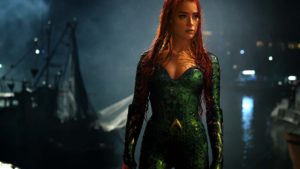
The cast is great too! Jason Mamoa really carries the movie as Arthur “don’t call my mom Martha” Curry. While his lines suck, he and the rest of the cast do their best with a wacky script. Amber Herd is good in this as well, acting as a good partner and fiercely capable warrior. Willem Dafoe and Patrick Wilson are great in their roles as well. Wilson really hams up the scenes he is in, but is obviously having fun with the character. This movie deserved an over the top, loud villain, and we got one with Ocean Master. Don’t get me wrong, there is so much ham in this movie, but if anything, the cast softens that blow.
The element of fun was always missing from DC movies of today, and Aquaman finally breaks that trend. This is a step in the right direction for the whole DC franchise, and I am hoping the other movies and projects are able to tap into this. Listen, I as much as anyone want a dark DC movie universe, but they tried it and it is just not working for them. It was time to try something new and you get that with Aquaman.
Now don’t get me wrong….DC has a long way to go to catch up with MCU. I cannot express enough how much I want DC to succeed, as I personally favor their characters more. Marvel just remains ahead, and it’s thanks to that early start and just an understanding of the source material. It is not too late for DC, and Aquaman really displays their understanding of the course correction that is in need. I don’t think it ever reaches the highest moments of Wonder Woman, but I think it has a more consistent quality as there is not an entire act that just falls apart like the third act does in Wonder Woman. While Wonder Woman is very good at many moments, I still don’t know if there is anything that is particularly very good about Aquaman, while at the same time not being particularly bad. I just see the changes and it fills me with a sort of optimism about things going forward.
DC has done plenty to earn the distrust of fans and consumers alike. If you genuinely like the movie, great! This is not to demonize the people who enjoy these movies, but I do hope that the current fans are accepting of the incoming changes. Aquaman is not a perfect film, heck it is hardly even a good one, but it gets a lot of the right stuff correct, and that helps me forgive its many shortcomings. It’s not bad…but it is just fine.
Want more out from the underground?
The fastest way to hear more from us is to support our efforts by donating or get monthly perks by becoming a patron on Patreon!
Got an idea for a future debate? Let us know what you want to hear by joining our Discord server!
Follow us on Facebook or tweet to us @SubCultured using the hashtag #MasterDebaters!
Join us on our Twitch channel every Monday, Wednesday, and Friday at 9PM CST!
Subscribe to our YouTube channel!
After switching to its now bi-monthly release schedule, Doomsday Clock returned last week with Issue #4, which picks up straight after last issue’s cliffhanger ending and focuses on the origin of the mysterious new Rorschach. The story jumps between Rorschah’s previous stay in a mental asylum post-Watchmen and his current incarceration in Arkham Asylum.
Of the two plot lines to follow, the flashback story is the most intriguing. Following the newer Rorschach after the New York attack it’s revealed that not every person exposed to the “alien invasion” died instantly. Many suffered from horrific visions and are left severely traumatized. One of these victims is Reggie, a young man whom writer Geoff Johns wisely connects to the original Rorscach through his relationship to his father. Providing Reggie with an interesting perspective on a character most others consider to be a crazed vigilante.
Symmetry as a theme is present throughout this issue in both the art and writing, with Reggie’s confinement in both timelines mirroring one another and obligatory nods to Walter Kovac’s capture in the original Watchmen. Reggie’s decision to spare Ozymandias towards the end is an example of a man not beholden to the same strict code of his predecessor allowing the character to share many of the same traits but with an added element of unpredictability. Where the story diverges, however, is with the introduction of Mothman.
Mothman is used skillfully by Johns not only to provide a mentor for Reggie, but also as an explanation for how he was able to assume the persona of a new Rorschach and obtain the tools required to confront the man responsible for his parents death.
As a character, Mothman provides a warmth and humour in what would be an otherwise dreary setting. Mothman’s eventual fate is heartbreaking in it’s execution, as are his letters to an estranged sister, which serve as this issues epilogue. This is a character whose inclusion could verge too far towards fan service in another writers hands, but thankfully Johns allows the character to be an essential part of the narrative instead of a throwaway gag or lazy reference.
Another character who arrives in the final few pages is Saturn Girl, something of a reward for fans who have been reading DC Rebirth since its launch. Up until this point, Saturn Girl had only appeared in small cameos, hinting at a connection to the wider Doomsday Clock story. It’s nice to see threads like this finally begin to converge, even if her escape from Arkham could throw up more questions than it answers. The final page delivering an image guaranteed to leave readers discussing its symbolism and implications for the narrative going forward.
It is now a given to say that Gary Frank’s art continues to impress this issue. Mothmans late night flight is the obvious highlight and the overall pacing and detail of each page once again compliments Johns writing perfectly, demonstrating a symbiotic storytelling relationship similar to the one shared by Alan Moore and Dave Gibbons. Frank’s smaller details, such as the halls of Arkham resembling those in The Killing Joke, is a delightful example of these two creators weaving a DC universe intrinsically connected to Alan Moore’s previous work.
Doomsday Clock continues to be THE comic book event of the year. If Geoff Johns and Gary Frank continue this level of quality for the entire run, it’s sure to be considered a modern classic.
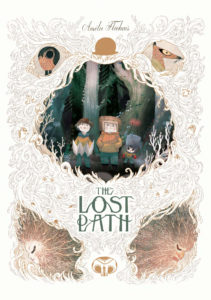 Adventure stories for children starring children will never go out of style. From Alice’s Adventures in Wonderland to The Neverending Story to Goonies, there’s a great thrill in young ones being able to see themselves as the protagonists in exciting situations. The Lost Path by Amélie Fléchais is one such tale in which a trio of boys find themselves in the thick of a secret world of strange and wondrous creatures, but how does it measure up to some of the classics?
Adventure stories for children starring children will never go out of style. From Alice’s Adventures in Wonderland to The Neverending Story to Goonies, there’s a great thrill in young ones being able to see themselves as the protagonists in exciting situations. The Lost Path by Amélie Fléchais is one such tale in which a trio of boys find themselves in the thick of a secret world of strange and wondrous creatures, but how does it measure up to some of the classics?
With some writing help by Jonathan Garnier, The Lost Path is written and illustrated by Fléchais. The book opens with a fairy tale of an older couple whose spirits are trapped by the forest before it quickly transitions to boys playing a scavenger hunt in the forest. They get lost and as the night grows darker, they find their situation growing stranger as they move deeper into the forest.
The story itself feels heavily influenced by Where the Wild Things Are, a notion that is supported by the Maurice Sendak quote that proceeds the book. The boys interact with the creatures, not understanding the world that they’ve arrived in, and with no understanding of the dangers they face. In addition to this, I find a lot of influence from Alice’s Adventures in Wonderland in the way the plot revolves around the forest guardian and the quest for the crown. Both of these are ideal stories to draw inspiration from for a children’s book of these sorts as they are seminal classics, but I don’t think Fléchais really handled the interpretation of the themes properly.
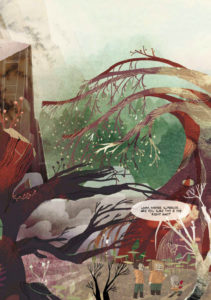 The problem with the story is that the boys don’t do anything. They’re simply reacting to everything that happens around them. They don’t learn any lessons, they don’t affect the world in any way. Their only purpose is to witness the events and they, and by extension the reader, don’t get the chance to see anything through to the conclusion. That’s one of the major shortcomings of the book, in that the story doesn’t really matter. (We don’t even discover the outcome of the scavenger hunt.)
The problem with the story is that the boys don’t do anything. They’re simply reacting to everything that happens around them. They don’t learn any lessons, they don’t affect the world in any way. Their only purpose is to witness the events and they, and by extension the reader, don’t get the chance to see anything through to the conclusion. That’s one of the major shortcomings of the book, in that the story doesn’t really matter. (We don’t even discover the outcome of the scavenger hunt.)
One of the things that turned me off most about The Lost Path was its abrupt ending. While the kids’ journey is an interesting one, the characters they meet are far more intriguing, but Fléchais never dives into any of them. I wanted to learn more about the fox and his supersonic bike, or the moose and how he got the bowler hat, or even what the deal was with the hat. Unfortunately, all of these characters are just incidental, there to give the boys a sense of wonder. Since the story is told from the perspective of the boys, once they are out of the woods, we lose all connection to these strange and wondrous creatures. Their tales are never finished and that’s just a shame.
The book’s art is breathtaking. The illustrations by Fléchais are magnificent and really bring her world and characters to life. Her style suits the creatures she’s created and I love the spin she gives the look of the humans. Each of the boys is unique and easily decipherable at a glance. I also loved the sparse use of color in the book. Most of the pages are black and white, rendered in great detail, but every so often readers are treated to a page of full, vibrant color, which makes the scene more dramatic when juxtaposed against the monochrome panels.
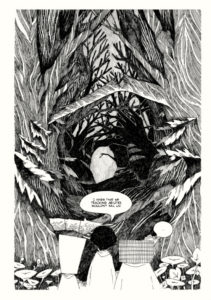 The art also does a great job of slowing down the reader. The Lost Path has a very fast paced story, with so much happening in so few pages that it’s easy to breeze through the whole thing, but the highly detailed art forced me to pause and pour over the details in the minutiae on page, which helped me to digest the story better.
The art also does a great job of slowing down the reader. The Lost Path has a very fast paced story, with so much happening in so few pages that it’s easy to breeze through the whole thing, but the highly detailed art forced me to pause and pour over the details in the minutiae on page, which helped me to digest the story better.
The Lost Path is beautiful visually but doesn’t pack much originality. I would have preferred to spend more time with the Guardian, learning about her kingdom, or some of the animals in the forest. It was slightly disappointing that Fléchais gleaned over all of these interesting situations and themes, instead focusing on the boys finding their way home. I understand her decision, though, as this story felt aimed for children. All in all, it’s a good story for those who are interested in child adventure stories but doesn’t offer much depth.
Grade: B-
For a few years back in the early 2010s horror mash up stories were all the rage. Take an innocuous but well known thing and mix it with a fantasy horror trope and a new hit was made. These were most evident through books like Pride and Prejudice and Zombies and Abraham Lincoln: Vampire Hunter and probably a few others not written by Seth Grahame-Smith. Though that genre has been dormant for a few years, it’s come back quite well with the recent release of Harriet Tubman: Demon Slayer.
Written by David Crownson, Harriet Tubman: Demon Slayer takes place (appropriately) in 1860, deep in the heart of America’s days of Slavery. It opens with a slave family, the Edgefields, as they escape their plantation in search of a life as free folk. When they run afoul of a trio of shady white men, the Edgefields stand their ground only to discover that these men aren’t exactly what they seem to be. Luckily, a mysterious stranger, the eponymous Harriet Tubman, shows up to save them.
One of the things I liked most about the book is the humor. Within the first couple of pages, Crownson makes a joke at the expense of one of his characters and it’s brilliant because it serves a higher purpose than a mere moment of levity. In addition to setting the tone for the book, that initial joke lets the audience know that despite the heady subject matter, they’re allowed to laugh at the story. This is a necessary cue for readers like me, a middle class white man, during the times that the N-word gets bandied around. That word would (rightfully so) make modern audiences uncomfortable but was necessary to tell a story that borrowed heavily from the time of slavery and Harriet Tubman’s real-life struggle. Crownson breaks the ice early to alleviate any possible squeamishness.
The art on the book is superb. Courtland Ellis’ art is smooth, his figures realistic and graceful. There are no overly muscular men rippling through torn shirts. His women aren’t bodaciously disproportioned, and in fact have noticeably different body types. Ellis uses subtle facial expressions on his characters to portray emotions and tip the readers off to what they’re thinking, but he’s then able to go all out during the funny moments. It can be a jarring juxtaposition at times but really ramps up the humor.
The art isn’t perfect, though. Most of the pages are beautiful, however, there’s some panel progression that feels off. Some of the character movement is choppy and stilted, which is detrimental in a book that relies heavily on fight scenes. Thankfully, it’s easy to overlook because there are so many other things to enjoy but hopefully it improves as the series progresses.
Ellis also shines in how he draws backgrounds, notably in the way he uses large brushstrokes to signify foliage. It’s drastically different from mainstream comics and I absolutely love it.
My biggest problem with the book is the dialogue. While most of the characters’ speech is smooth and energetic, the story is sprinkled with one-liners that just seem trite and unnecessary. It tended to be more good than bad, though.
I also wasn’t a fan of the localized dialect. This was probably included to show how different groups speak differently and was effective in establishing the world the story takes place in. I felt like it slowed down the reading experience, forcing me to puzzle out what the characters were saying. I understand that I’m splitting hairs here and maybe sound a little pedantic but this was definitely my take away from the reading experience.
Also, I need to point out the book’s poor punctuation. Normally I don’t even notice the lettering in comic books but the fact that this drew my attention means that it really stood out. Granted, some of the punctuation choices may have been stylistic but there are some instances that are just inconsistent, making the lettering come off as lazy or rushed. Again, I have hope that this will be remedied in future issues.
Despite its flaws, though, one thing that Crownson gets right is the mystery surrounding Harriet Tubman: Demon Slayer. His opening chapter focuses on establishing the characters. He doesn’t dive too far into why the vampires are chasing runaway slaves or even where Harriet comes from. We know nothing of her past, her upbringing, or how she knows how to fight. Crownson reveals just enough to whet my appetite but not too much that I lose interest and don’t return for the second issue.
Having purchased Harriet Tubman: Demon Slayer on a whim during Free Comic Book Day (it was funded through a successful Kickstarter), I have no idea how to get a physical copy of the book. However, you can buy it in digital on Comixology and Peep Game Comix. And I wholly recommend you pick it up. Not only is this book a fun read but it’s also an interesting take on the horror mash-up genre and the life of one of the most prolific American humanitarians.
Grade: B-
As one of the smaller independent presses, Lion Forge Comics is not very well known. Most of their line up consists of comics based on popular 80s franchises (as well as a few not-so-popular). As of recently, though, they are jumping into the super hero game, starting with the release of Catalyst Prime: Noble, a prelude to their upcoming Catalyst Prime universe.
The premise behind Catalyst Prime is that a massive asteroid is heading to Earth and only 5 astronauts are able to stop it. It’s a fairly straight forward premise, one that leaves a lot of room to work with. We’ll learn more about what they’re calling “The Event” on Free Comic Book Day when Lion Forge gives out copies of Catalyst Prime: The Event. From there, the Catalyst Prime universe will slowly unfold in seven monthly comic books. One of these is Catalyst Prime: Noble, which focuses on David Powell, one of the astronauts involved in The Event and what becomes of him in the following year.
The main cast of Noble is only two characters, the aforementioned David and his wife, Astrid. Writer Brandon Thomas was wise to structure the introductory chapter like this as it made it easy to follow. Being new characters, we don’t know much about the kind of people David and Astrid are, so throwing a wide cast at new audiences may become confusing and alienate readers. By paring that down to two, especially two who are so closely tied together, Thomas create a far simpler reading experience while getting the most out of the story.
Most of the issue focuses on David, who has no idea who he is but shows some powerful telekinetic abilities, being pursued by a specialized military team. Everything is left ambiguous; we don’t know why David’s on the run, why these men are chasing him, or who the mysterious “she” is that sent them. It’s a well written, well paced scene that’s enhanced by Roger Robinson’s art.
What I like most about the art is Robinson’s style. He uses a lot of lines, most especially in his figures and when indicating motion. It’s very different from a lot of the more mainstream comics and lends the book a gritty feeling. I use “gritty” as it’s supposed to mean; coarse and dirty, not dark and broody as it’s become to be known. Which I mean as a compliment. The scene involved David being chased by a group of large men through a sandy, desert town. One word that should be used to describe this is “gritty.”
The panel progression is very cinematic. From the very first page we get a slow zoom out from Astrid’s wedding ring as she sits nervously in a waiting room. This transitions to a flashback of not long before, revealing the reason she’s nervous. That lasts less than a page before we return to the present moment, when Astrid is given terrible news and breaks down in tears. Three pages is all it takes to recap her harrowing experience losing her husband in The Event and it’s all that’s needed. Wonderful work by both Thomas and Robinson.
I also loved the end twist. It’s a pretty big reveal that most writers would dangle in front of readers, dropping little clues here and there through subsequent issues in order to keep them on the hook. But Thomas tells us up front at the end of the issue who is masterminding the hunt for David. It’s a great reveal because it opens so many more questions that entice readers to come back without resorting to clichés and cheap tricks.
As a fan of super heroes, it’s nice to break away from the worlds of Marvel and DC, which are steeped in so much history that it’s often difficult to keep up. Catalyst Prime offers a reprieve from that, with strong characters that we get to see evolve and grow in real time. It’s also great to see a comic so deftly blend the techniques of filmmaking into its storytelling. I hadn’t heard much about Catalyst Prime before reading Noble but now I’m definitely looking to go deeper into the universe.
Grade: B


